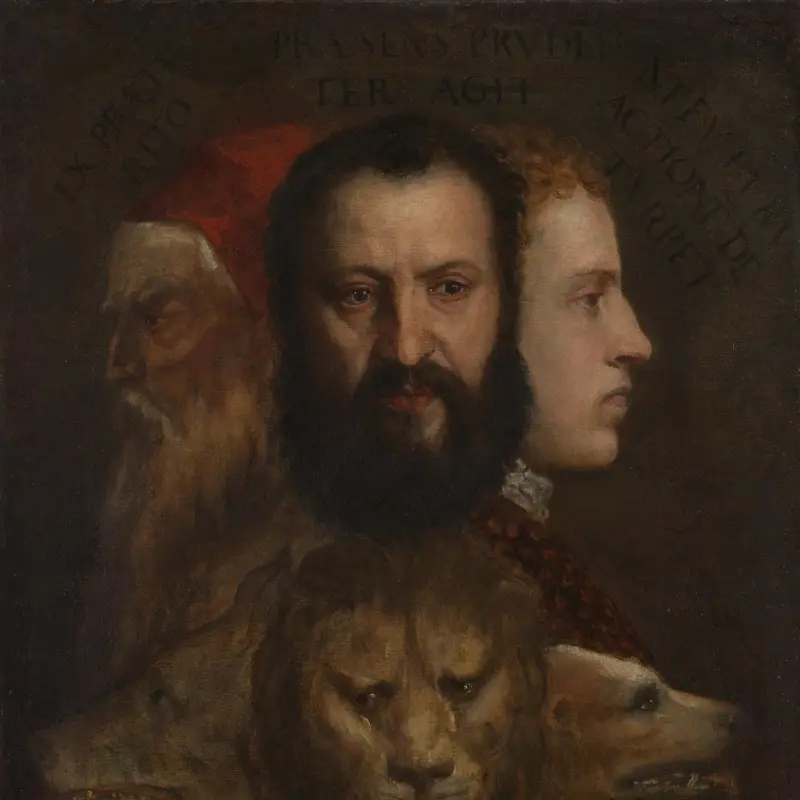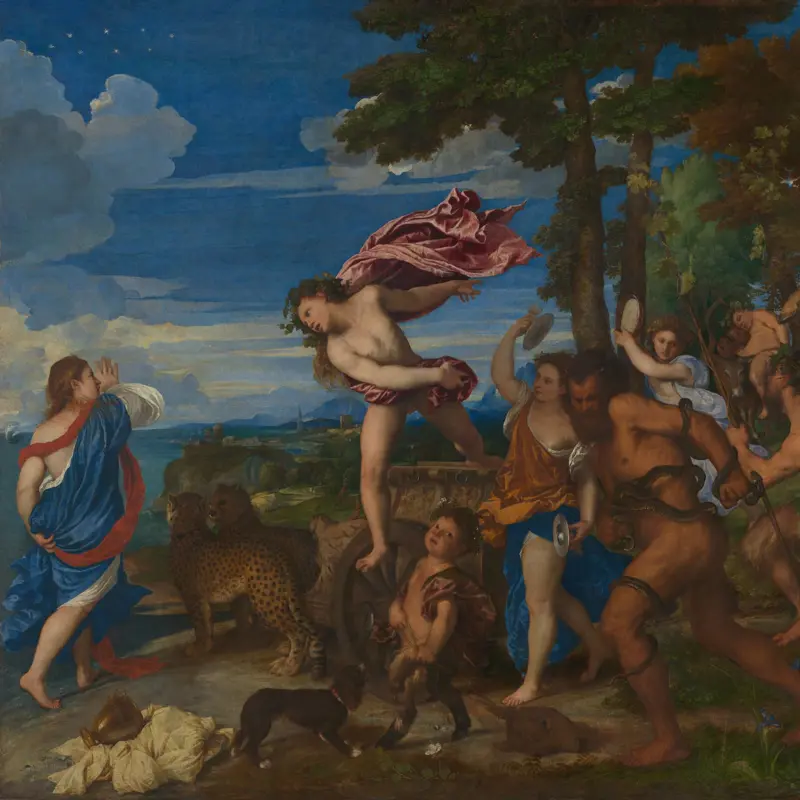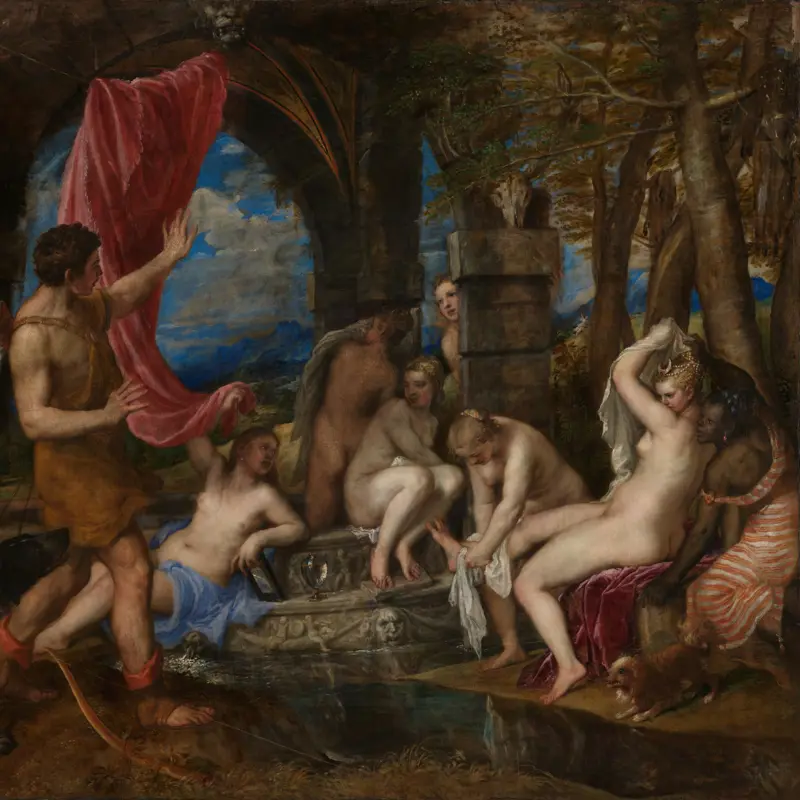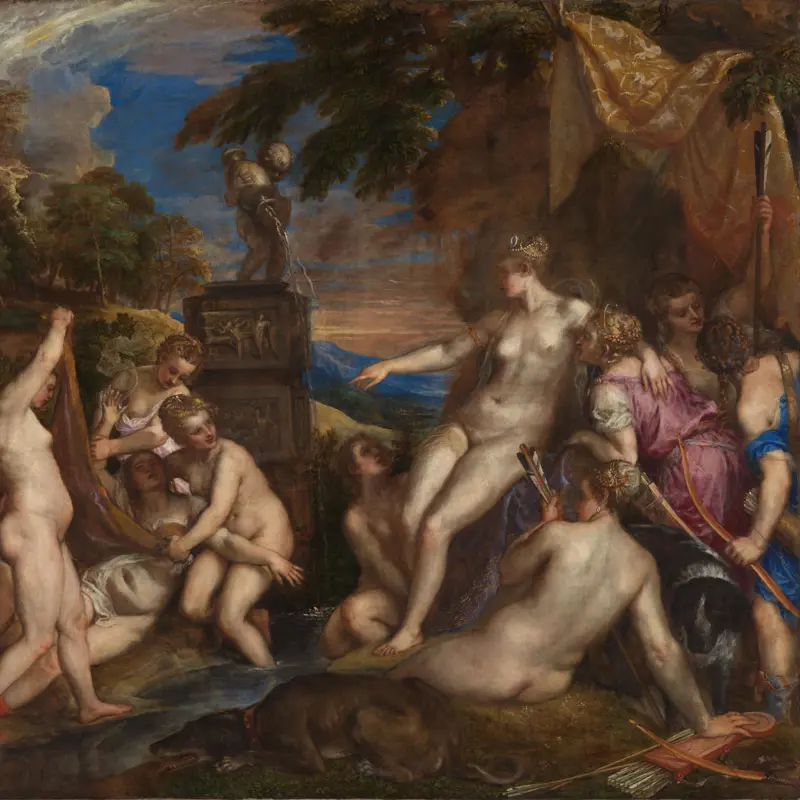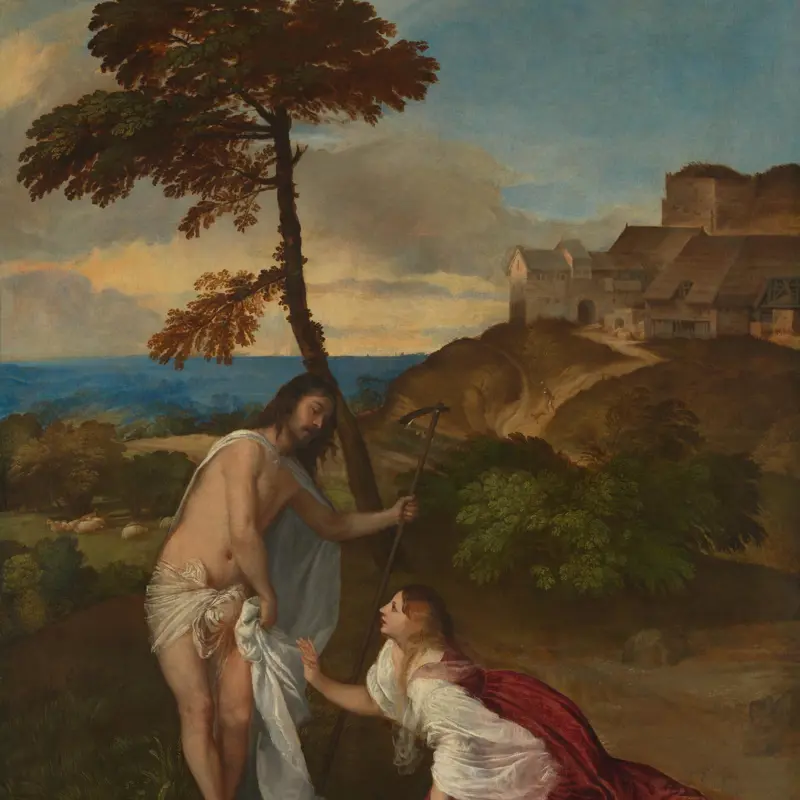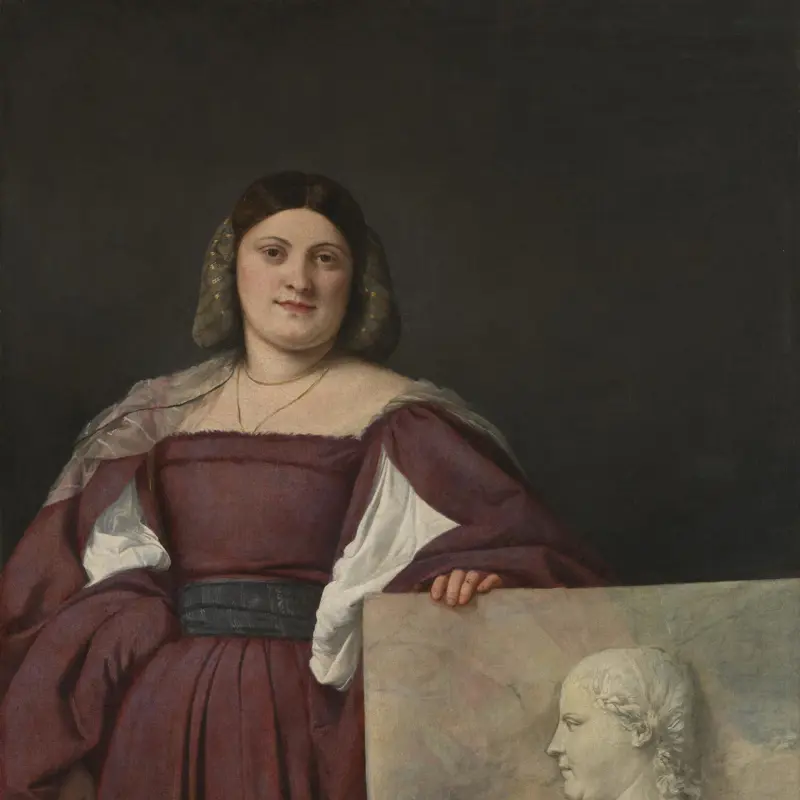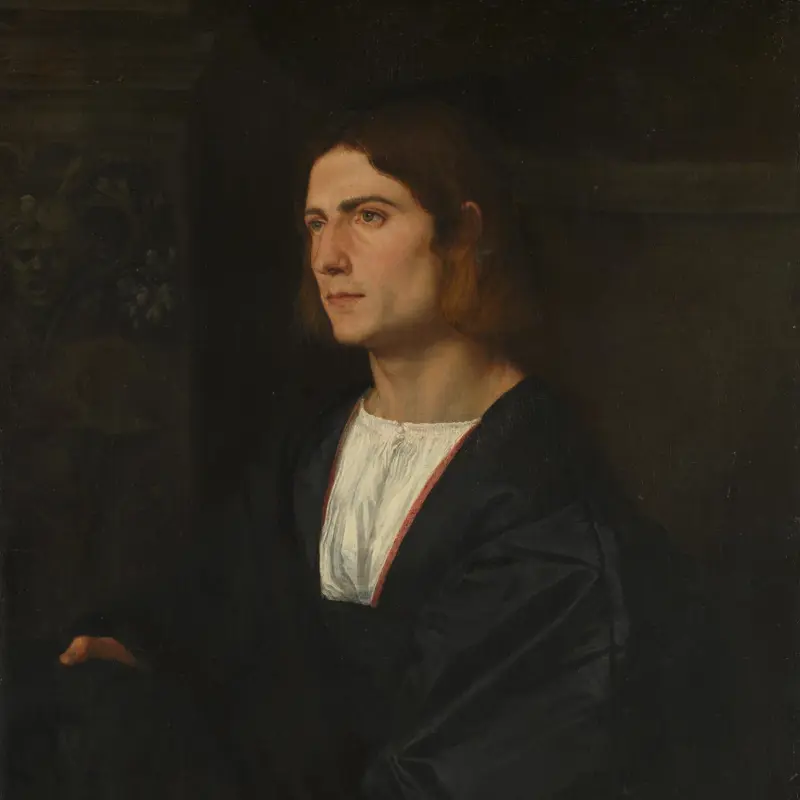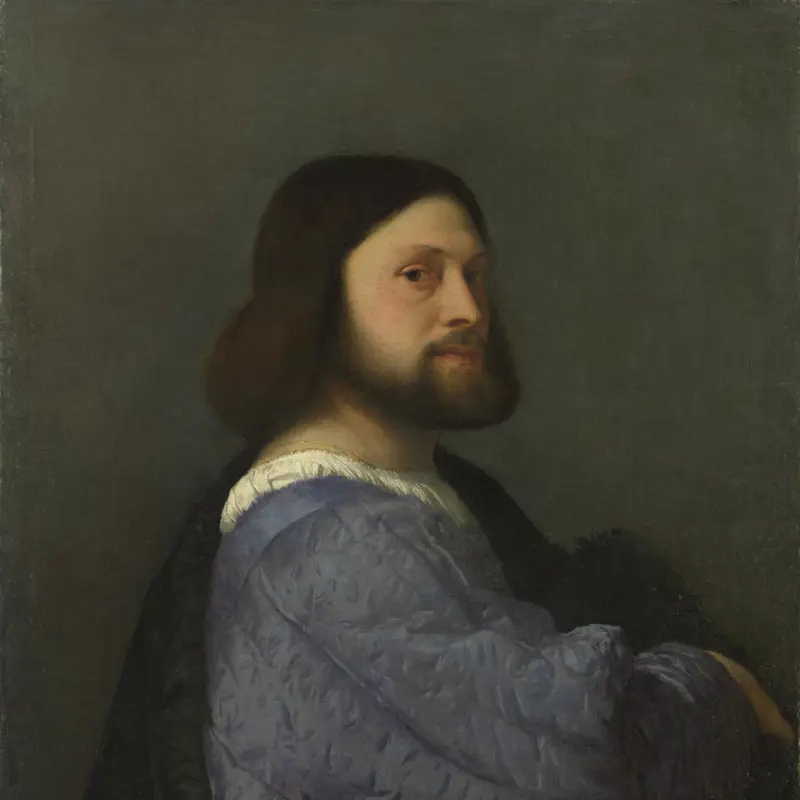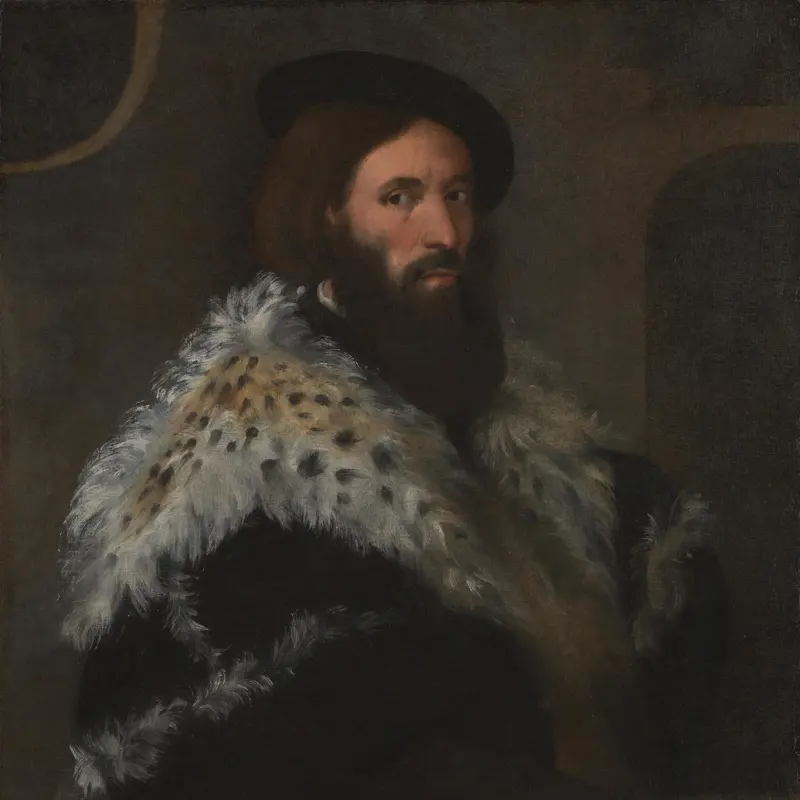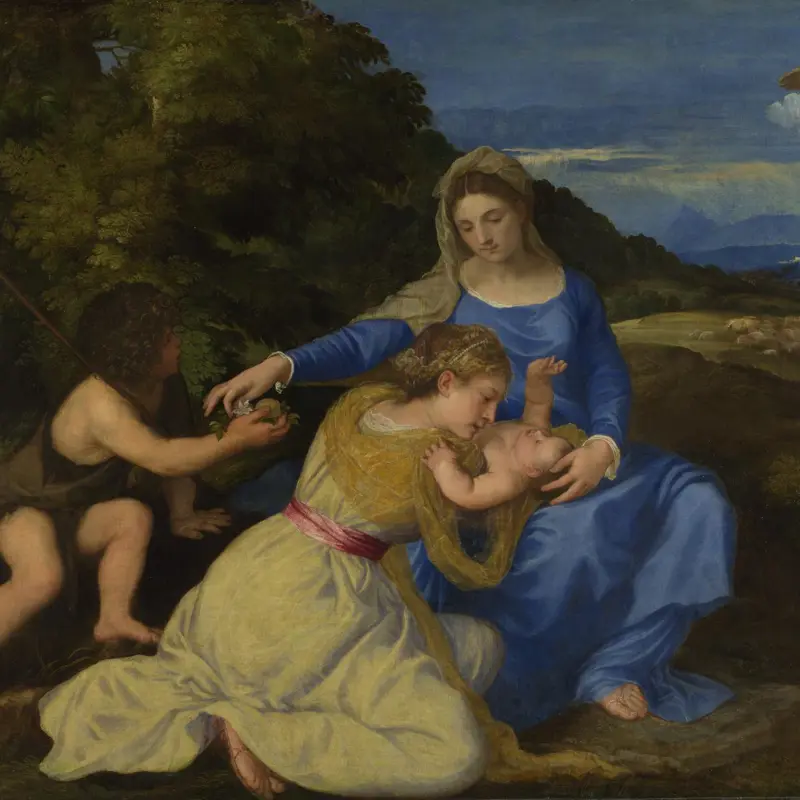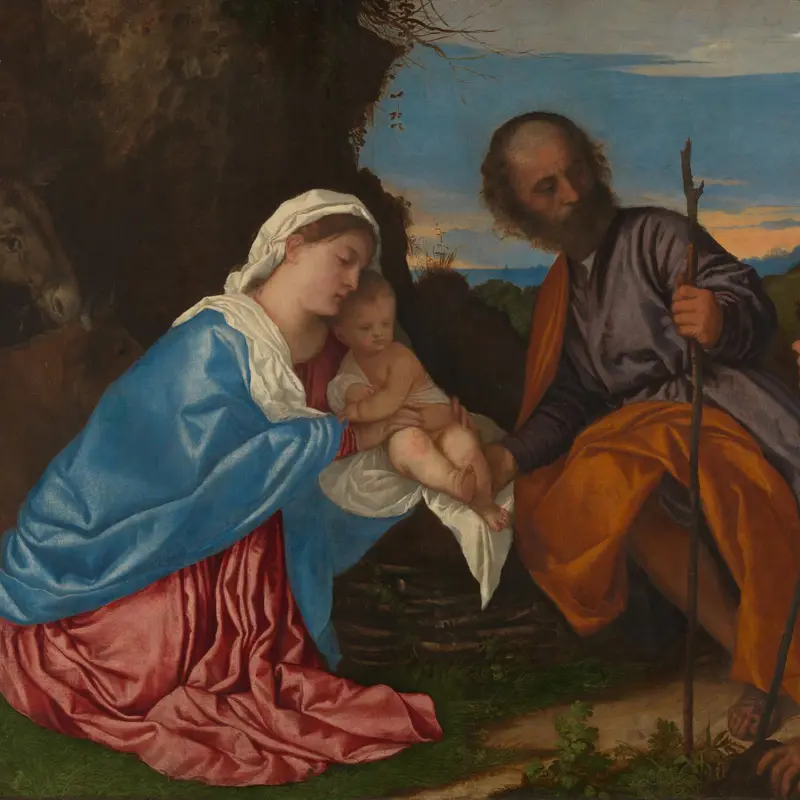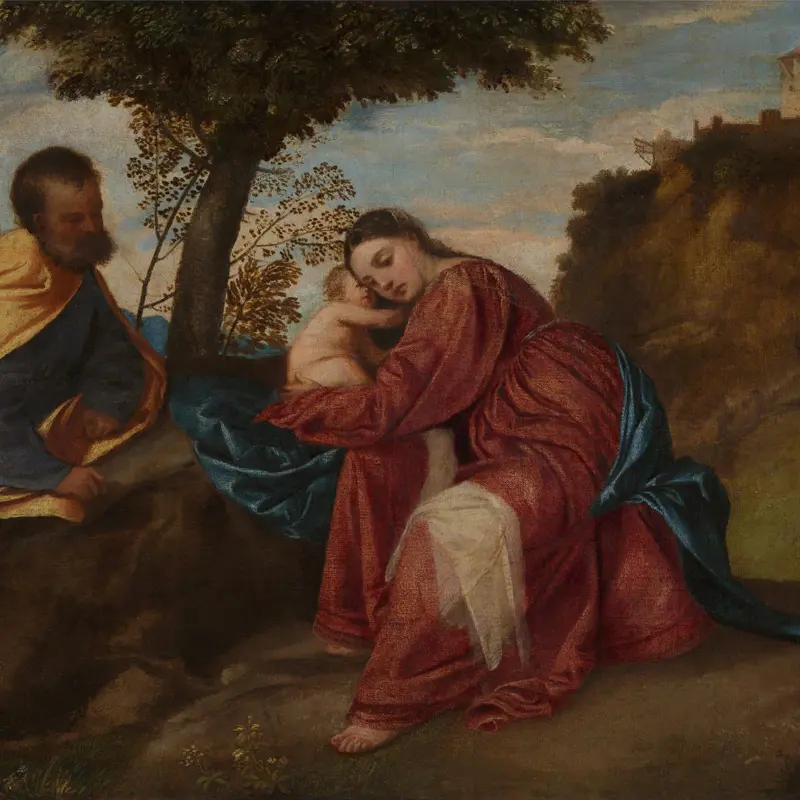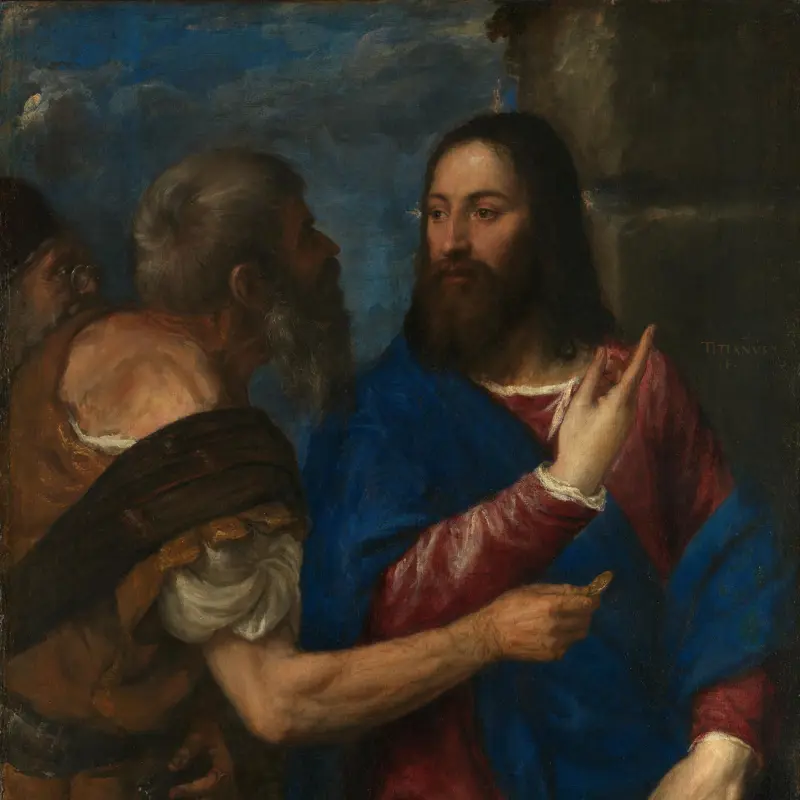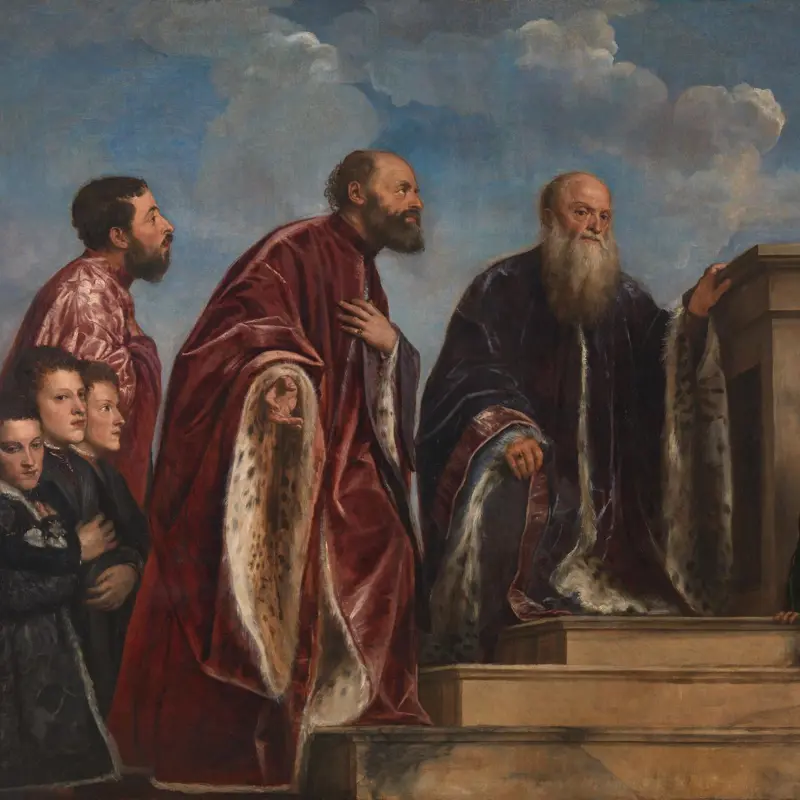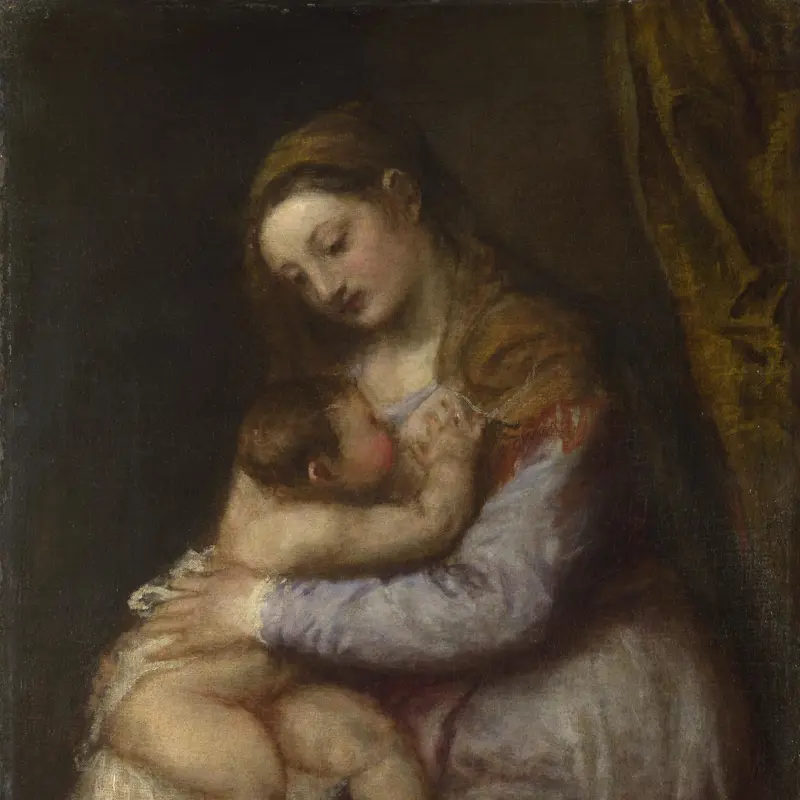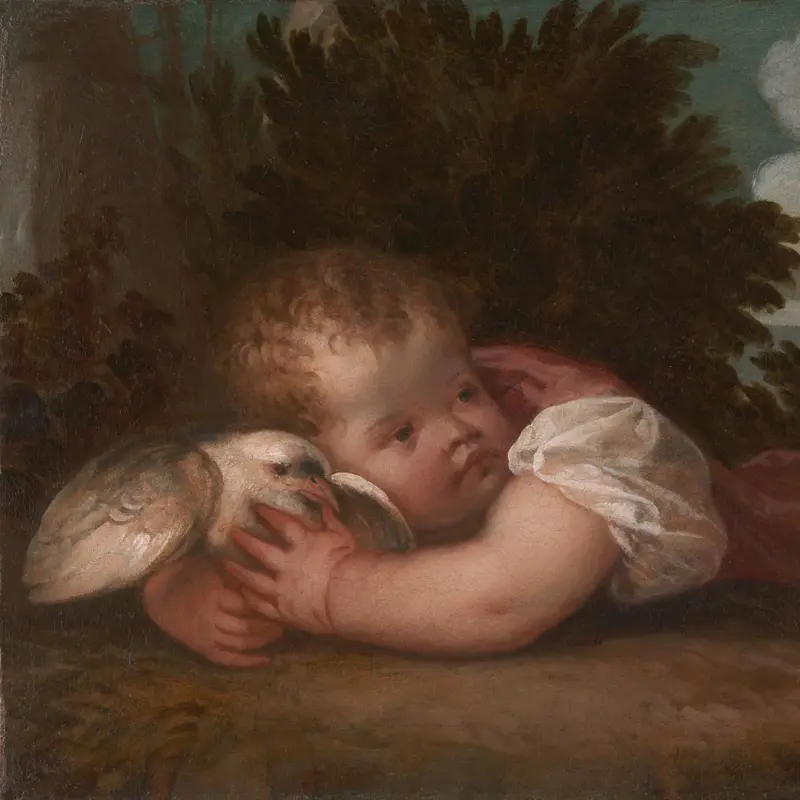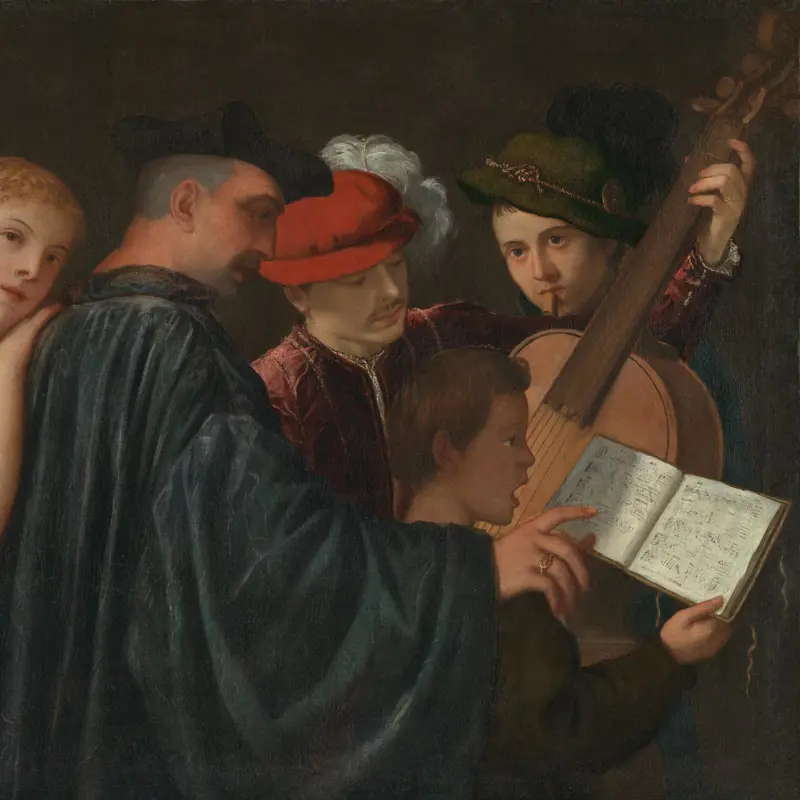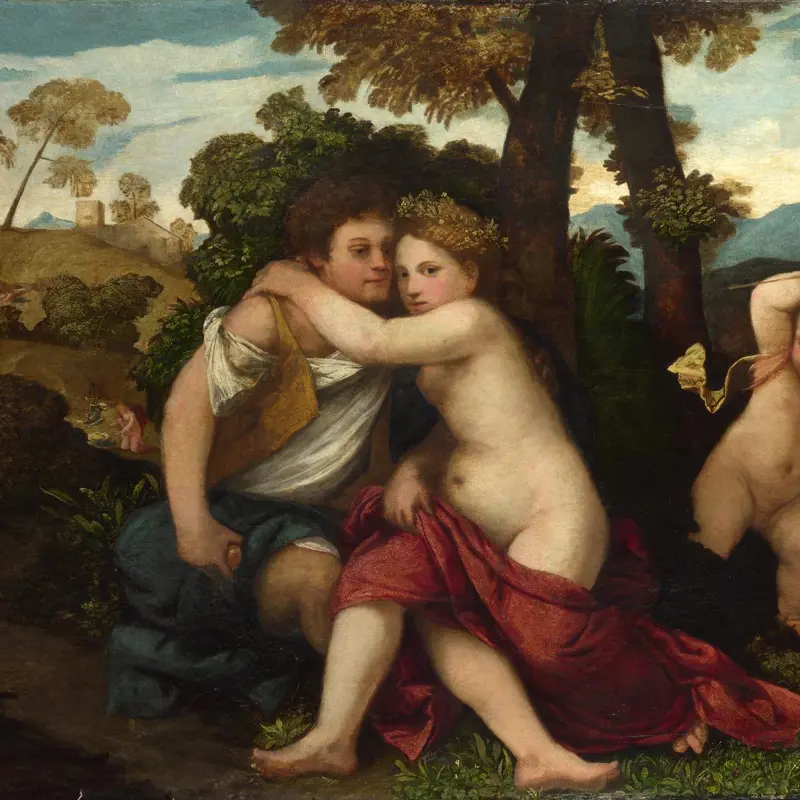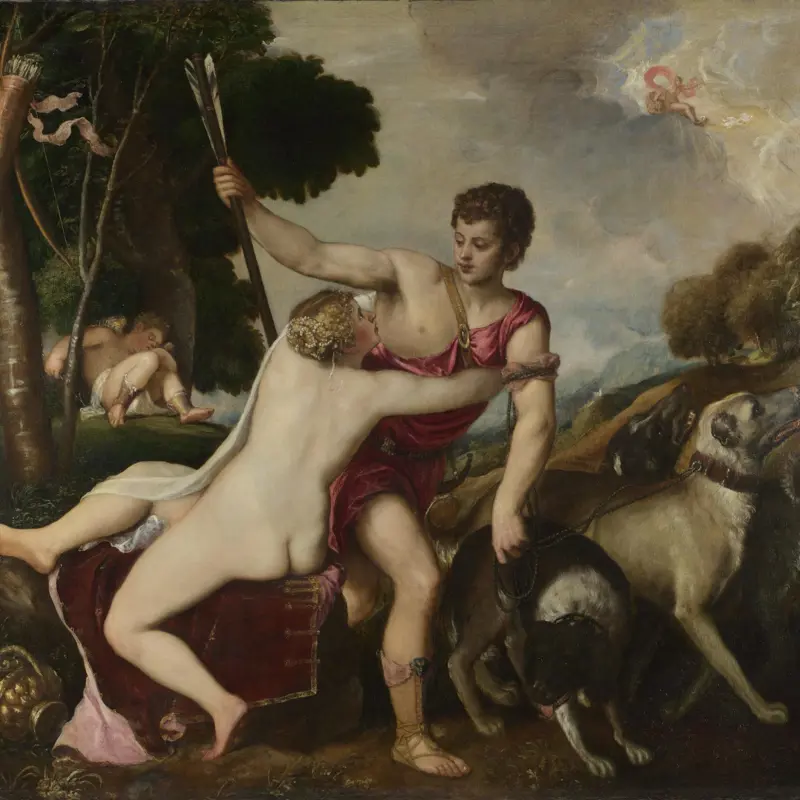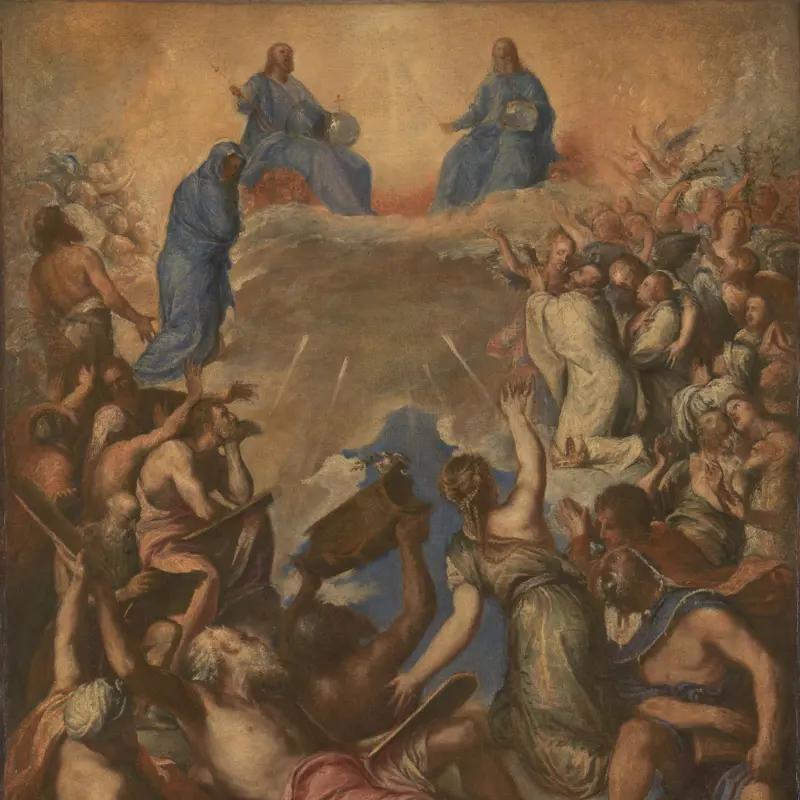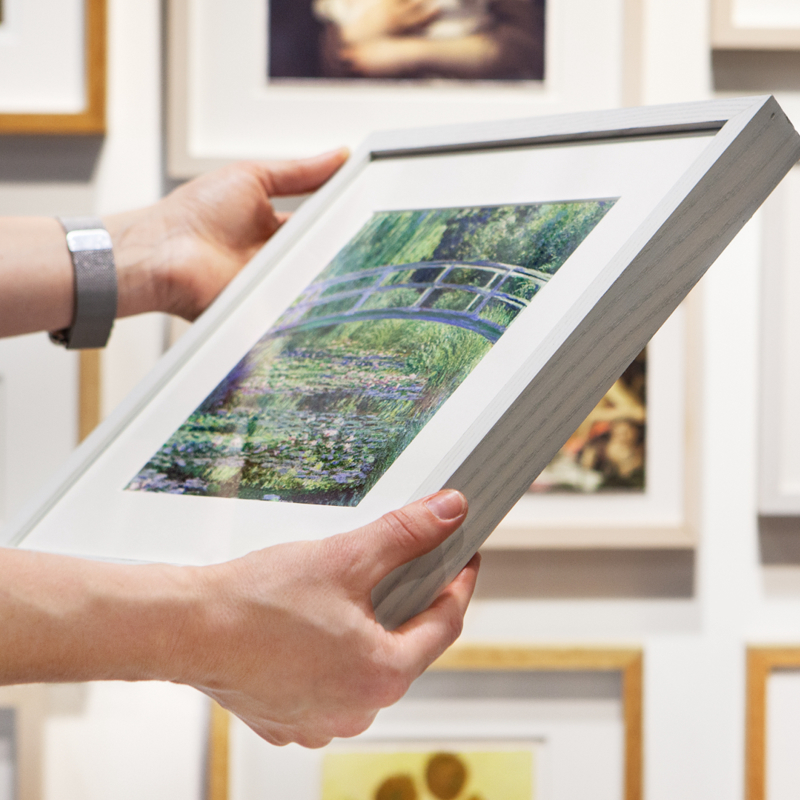Titian, 'The Death of Actaeon', about 1559-75
About the work
Overview
The story of Actaeon is told in the Metamorphoses by the Roman poet Ovid. In Titian’s earlier Diana and Actaeon, painted for King Philip II of Spain in 1556–9 and now jointly owned by the National Gallery and the National Galleries of Scotland, Actaeon disturbs the goddess Diana and her nymphs at a secret bathing place.
Although never delivered to Philip, The Death of Actaeon is clearly its sequel: Actaeon flees and, stopping to drink at a stream, discovers from his reflection that Diana has turned him into a stag. Titian shows Actaeon in the process of transformation, while he is being torn to death by his own hounds. The death scene was rare in Italian art and Titian may never have seen another painting of it.
While conceived around 1559, The Death of Actaeon was mostly painted when Titian was in his mid-eighties. It may not be entirely finished and could be one of the pictures left in his studio at the time of his death.
Audio description
Listen to an audio description of Titian's 'The Death of Actaeon'
Transcript
This is a description of 'The Death of Actaeon' by the Venetian artist Tiziano Vecellio – or Titian, as he is better known. A work of oil on canvas, this is a large painting, almost 2 metres wide and about 1.8 metres tall. The frame is a thick dark colour with beaded decoration, heavily gilded shell and scroll motifs.
It was started when Titian was in his seventies and was possibly still in his studio at the time of his death in 1576.
The setting is a windswept forest landscape, with Diana on the left, goddess of the hunt, from Greek and Roman mythology. She is pursuing Actaeon who is on the right. The scene is washed with a soft, warm light from the top left, with darker tones of earthy umbers, ochres and olive greens. Cutting through the middle ground, from left to right, is a fast moving stream, the light dancing on its rippling water. To suggest the turbulence, Titian has used a technique known as scumbling, applying a white layer of paint, over blueing, grey tones. The stream winds its way into the foreground of the painting, separating the two protagonists.
Diana, holding her bow in front of her, is bursting into the painting in the foreground on the left, her trailing foot cut off by the edge of the picture. An imposing figure, her height reaches two thirds of the way up the composition. She wears a knee-length tunic of rose pink, the low neckline exposing one breast. She’s in profile, but her upper body is twisted round to face us, her right arm drawn back, as if she has just launched an arrow while on the move. Her strawberry-blonde, ringleted hair is pulled loosely onto the top of her head, secured with a band of red leather and pearls, which match the bracelets on each arm.
Behind her, in the top left, is a turbulent sky, with scudding clouds, their soft volume painted in warm pink, greys and highlighted in white. Here unfortunately, the blue of the sky – once a brighter hue - has degraded to a grey, dull tone.
Actaeon is on the other side of the stream, the forest behind him. He’s set further back in the composition, so appears much smaller than Diana. He is transforming into a stag. His bare torso is in human form, but antlers emerge from his forehead, and his legs have sprouted brown fur. Arms thrown up, he stumbles back towards the right edge of the painting. His lean bodied hounds of brown, black and white are attacking him, two leaping up at his torso, a third snapping at his knees. A fourth races to join them.
Just visible in the distance between the trees, silhouetted against the silvery sky, is the sketchy shape of a horse and rider, possibly one of Actaeon’s hunting party.
In Ovid’s account of this myth, Diana is enraged at Actaeon’s intrusion as she bathes with her nymphs in a woodland glade. Splashing water in his face she transforms him into a stag, and his hunting hounds chase him down.
The technique used by Titian in this painting has led to much debate over whether the work was actually finished. The brushwork is loose and feathery, the paint thin in places, and the string of Diana’s bow has not been painted.
Other paintings on this theme, 'Diana and Actaeon' and 'Diana and Callisto' are also in the National Gallery’s collection.
Key facts
Details
- Full title
- The Death of Actaeon
- Artist
- Titian
- Artist dates
- Active about 1506; died 1576
- Date made
- About 1559-75
- Medium and support
- Oil on canvas
- Dimensions
- 178.8 × 197.8 cm
- Acquisition credit
- Bought with a special grant and contributions from the Art Fund, The Pilgrim Trust and through public appeal, 1972
- Inventory number
- NG6420
- Location
- Room 8
- Collection
- Main Collection
- Commissioners
- Frame
- 16th-century Venetian Frame
Provenance
Additional information
Text extracted from the ‘Provenance’ section in Matthias Wivel, ‘Titian: Love, Desire, Death’ (exh. cat. National Gallery, London, 2020), London 2020; for further information, see the full catalogue entry.
Exhibition history
-
2012Metamorphosis: Titian 2012The National Gallery (London)11 July 2012 - 23 September 2012
-
2014Titian and the Golden Age of Venetian PaintingScottish National Gallery22 March 2014 - 14 September 2014
-
2020Titian: Love, Desire, DeathThe National Gallery (London)16 March 2020 - 17 January 2021
Bibliography
-
1727L.D. de Saint-Gelais, Description des tableaux du Palais Royal: Avec la vie des peintres à la tête de leurs ouvrages: Dédiée à Monseigneur le duc d'Orleans, premier prince du sang, Paris 1727
-
1819British Institution, Catalogue of Pictures of the Italian, Spanish, Flemish, Dutch, and French Schools, London 1819
-
1829A. Hume, Notices of the Life and Works of Titian. Descriptive Catalogue of Engravings after the works of Titian, from the Bibliothèque du Roi, London 1829
-
1838G.F. Waagen, Works of Art and Artists in England, trans. H. Lloyd, vol. 2, London 1838
-
1854G.F. Waagen, Treasures of Art in Great Britain: Being and Account of the Chief Collections of Paintings, Drawings, Sculptures, Illuminated Mss. […], vol. 2, trans. E. Eastlake, London 1854
-
1872Royal Academy of Arts, Exhibition of the Works of the Old Masters (exh. cat. Royal Academy of Arts, 1872), London 1872
-
1877J.A. Crowe and G.B. Cavalcaselle, Titian: His Life and Times, London 1877
-
1894New Gallery, Exhibition of Venetian Art, London 1894
-
1897J.O. Granberg, La galerie de tableaux de la reine Christine de Suède, Stockholm 1897
-
1911R. Fry, 'Exhibition of Old Masters at the Grafton Galleries, II', The Burlington Magazine, XX/105, 1911, pp. 161-7
-
1930C. Holmes, 'The Italian Exhibition', The Burlington Magazine, LVI/323, 1930, pp. 55-72
-
1933W. Suida, Tiziano: 304 tavole in fototipia, Rome 1933
-
1936T. Borenius, Catalogue of the Pictures and Drawings at Harewood House and Elsewhere in the Collection of the Earl of Harewood, Oxford 1936
-
1936H. Tietze, Titian: Leben und Werk, 2 vols, Vienna 1936
-
1950Royal Academy, Exhibition of Works by Holbein and Other Masters of the 16th and 17th Centuries, London 1950
-
1952E.K. Waterhouse, 'Paintings from Venice for Seventeenth-Century England: Some Records of a Forgotten Transaction', Italian Studies, VII, 1952, pp. 1-23
-
1957B. Berenson, Italian Pictures of the Renaissance: A List of the Principal Artists and Their Works, with an Index of Places: Venetian School, 2 vols, London 1957
-
1960F. Valcanover, Tutta la pittura di Tiziano, Milan 1960
-
1963C. Gould, 'The "Perseus and Andromeda" and Titian's "Poesie"', The Burlington Magazine, CV/720, 1963, pp. 112-7
-
1969H. Keller, Tizians Poesie für König Philipp II. von Spanien, Wiesbaden 1969
-
1969R. Pallucchini, Tiziano, Florence 1969
-
1969E. Panofsky, Problems in Titian, Mostly Iconographic, New York 1969
-
1969H.E. Wethey, The Paintings of Titian: The Religious Paintings, 3 vols, London 1969
-
1971B.C. Chiovenda, 'Atheone lacerato dai cani suoi', Commentari, 22, 1971, pp. 180-3
-
1972C. Gould, 'The Death of Actaeon and Titian's Mythologies', Apollo, 124, 1972, pp. 464-9
-
1973The National Gallery, The National Gallery: January 1971 - December 1972, London 1973
-
1975C. Gould, Delaroche and Gautier: Gautier's Views on the 'Execution of Lady Jane Grey' and on other Compositions by Delaroche, London 1975
-
1976M.C. Tanner, Titian, the Poesie for Philip II, Phd Thesis, New York University 1976
-
1978R. Pallucchini, Tiziano e il Manierismo europeo, Florence 1978
-
1980C. Hope, Titian, London 1980
-
1980Tiziano e Venezia: Convegno internazionale di studi, Venezia, 27 settembre - 1 ottobre 1976, Vicenza 1980
-
1981J.C. Nash, Poesie for Philip II, Phd Thesis, John Hopkins University 1981
-
1981D. Rosand, 'Titian and the Eloquence of the Brush', Artibus et historiae, II/3, 1981, pp. 85-96
-
1982J. Ingamells, '"Perseus and Andromeda": The Provenance', The Burlington Magazine, CXXIV/952, 1982, pp. 396-400
-
1984D. Sutton, 'Aspects of British Collecting, III.XIII: The Orléans Collection', Apollo, CXIX/267, 1984, pp. 357-72
-
1985J.C. Nash, Veiled Images: Titian's Mythological Paintings for Philip II, Philadelphia 1985
-
1987Gould, Cecil, National Gallery Catalogues: The Sixteenth Century Italian Schools, London 1987
-
1988B. Anatra, Venezia e la Spagna, Milan 1988
-
1988A. Gentili, Da Tiziano a Tiziano: Mito e allegoria nella cultura veneziana del Cinquecento, Rome 1988
-
1992A. Gentili, 'Tiziano e il non finito', Venezia cinquecento, II/4, 1992, pp. 93-127
-
1993D. Rosand, Titien: 'L'art plus fort que la nature', Paris 1993
-
1993M. Laclotte (ed.), Le siècle de Titien: L'âge d'or de la peinture à Venise (exh. cat. Galeries Nationales du Grand Palais, 9 March - 14 June 1993), Paris 1993
-
1994F. Ames-Lewis (ed.), New Interpretations of Venetian Renaissance Painting, London 1994
-
1995J. Brown, Kings and Connoisseurs: Collecting Art in Seventeenth-Century Europe, New Haven 1995
-
1995H. Walter and H.-J. Horn (eds), Die Rezeption der Metamorphosen des Ovid in der Neuzeit: Der antike Mythos in Text und Bild: Internationales Symposion der Werner Reimers-Stiftung, Bad Homburg V. D. H. (22. bis 25. April 1991), Berlin 1995
-
1996W.R. Rearick, 'Titian's Later Mythologies', Artibus et historiae, XVII/33, 1996, pp. 23-67
-
1997R. Goffen, Titian's Women, New Haven 1997
-
1998M. Mancini, Tiziano e le corti d'Asburgo nei documenti degli archivi spagnoli, Venice 1998
-
1998S. Cohen, 'Animals in the Paintings of Titian: A Key to Hidden Meanings', Gazette des beaux-arts, CXL/132, 1998, pp. 193-212
-
1999Museo Nacional del Prado, Tiziano: Técnicas y restauraciones: Actas del Simposium Internacional celebrado en el Museo Nacional del Prado los días 3, 4 y 5 junio de 1999, Madrid 1999
-
1999R. Cocke, 'Titian the Second Apelles: The Death of Actaeon', Renaissance Studies, XIII/3, 1999, pp. 303-11
-
2001
C. Baker and T. Henry, The National Gallery: Complete Illustrated Catalogue, London 2001
-
2001F. Pedrocco, Titian: The Complete Paintings, London 2001
-
2001V. Biermann, 'The Virtue of a King and the Desire of a Woman?: Mythological Representations in the Collection of Queen Christina', Art History, XXIV/2, 2001, pp. 213-30
-
2002A. Bettagano and M. Magrini, Lettere artistiche del Settecento veneziano, 4 vols, Venice 2002
-
2003D. Jaffé (ed.), Titian, London 2003
-
2003R. Wollheim, 'The Body Unfolding', Modern Painters, XVI/2, 2003, pp. 84-9
-
2003C. Hope et al., Titian (exh. cat. The National Gallery, 19 February - 18 May 2003; Museo Nacional del Prado, 10 June - 7 September 2003), London 2003
-
2004J. Lawson, 'Titian's Diana Pictures: The Passing of an Epoch', Artibus et historiae, XXV/49, 2004, pp. 49-63
-
2005T. Puttfarken, Titian and Tragic Painting: Aristotle's Poetics and the Rise of the Modern Artist, New Haven 2005
-
2007P. Sohm, The Artist Grows Old: The Aging of Art and Artists in Italy, 1500-1800, New Haven 2007
-
2007E. Tietze-Conrat, 'Venetian Painting of the Renaissance. The Late Titian', Studi tizianeschi, V, 2007, pp. 23-31
-
2008Penny, Nicholas, National Gallery Catalogues: The Sixteenth Century Italian Paintings, 2, Venice, 1540-1600, London 2008
Frame
This is a rare mid-sixteenth-century Italian Palladio-style frame crafted from poplar wood. The wide, shallow profile reveals its double-frame structure. The back moulding has a carved egg-and-dart motif and a blue painted frieze. Between this back moulding and the inner frame is a shell flanked by Sansovinesque scrolls. The inner frame has square outset corners with a lamb’s-tongue-and-tip motif. The frieze is lined in blue and gold and includes a double bead-and-reel motif, which surrounds painted rosettes at the corners. A further motif, with a flute and spear pattern, is set between the blue-painted and gilt surface.
The frame’s cut edges show that it was once integrated into a decorative scheme. The frame retains its original water gilding. It was fitted to Titian’s The Death of Actaeon in 2019.
About this record
If you know more about this work or have spotted an error, please contact us. Please note that exhibition histories are listed from 2009 onwards. Bibliographies may not be complete; more comprehensive information is available in the National Gallery Library.

